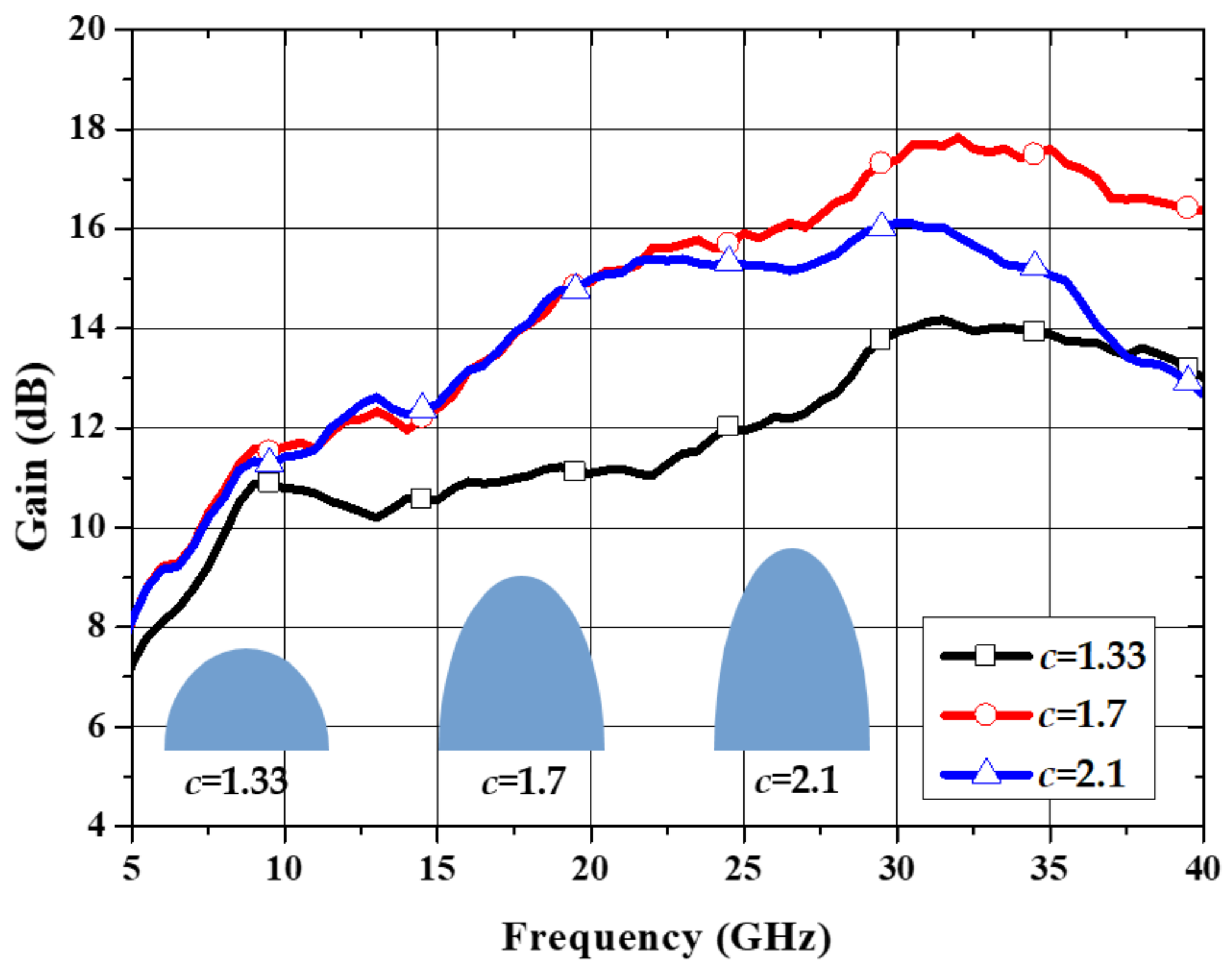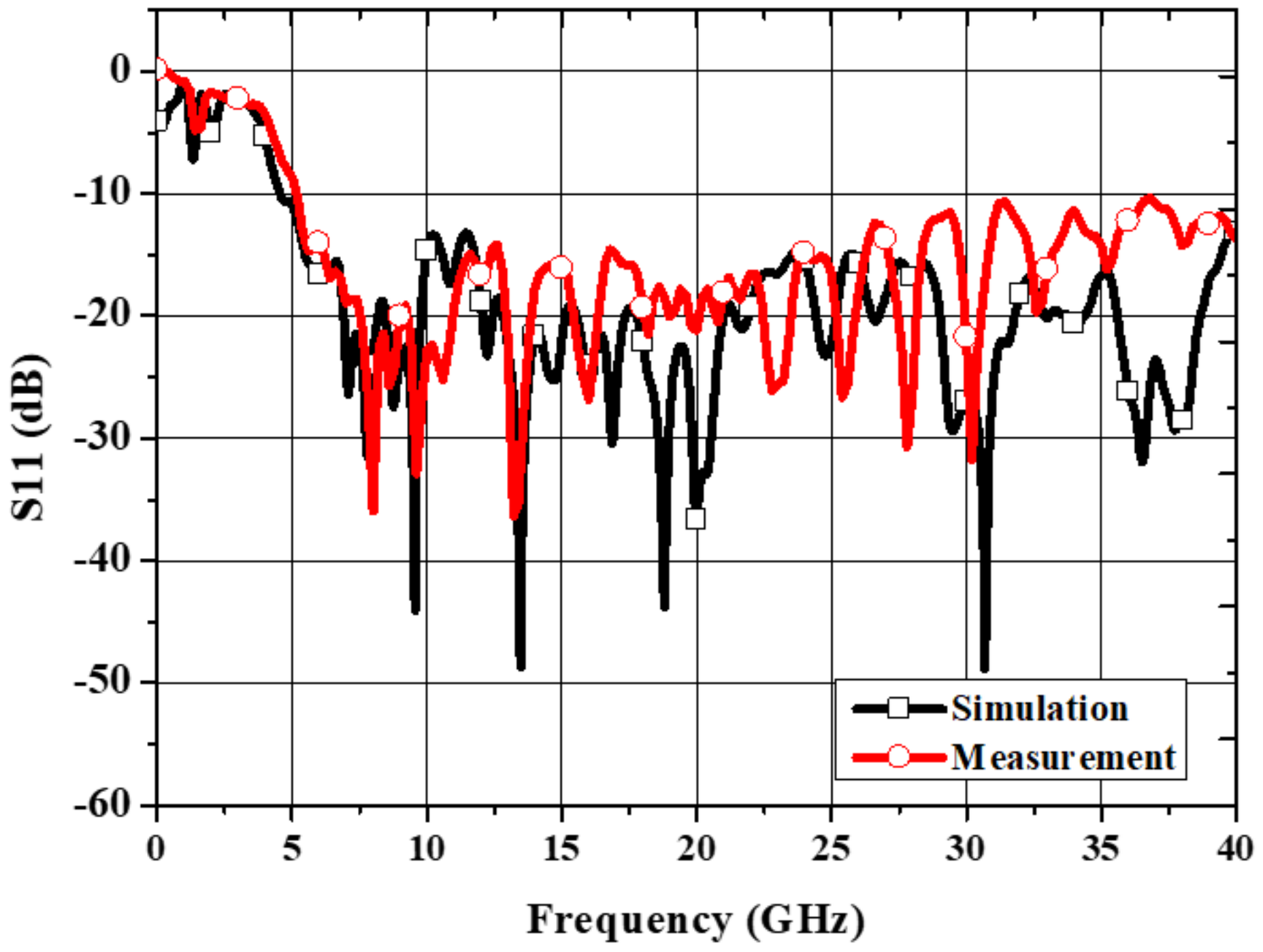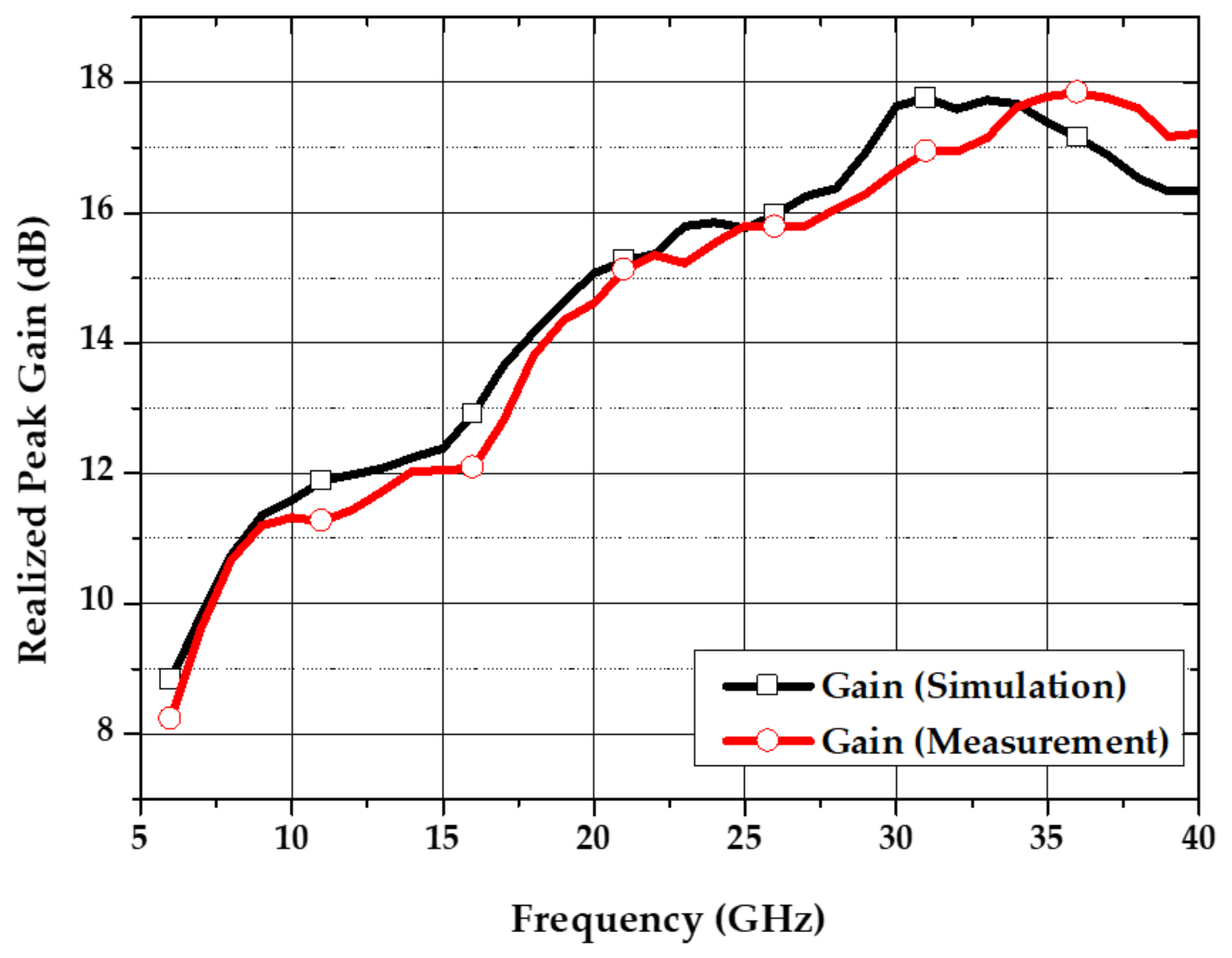Ultra-Wideband Trapezoidal Log-Periodic Antenna Integrated with an Elliptical Lens
Abstract
:1. Introduction
2. Antenna Configuration
2.1. Trapezoidal Log-Periodic Antenna (LPA)
2.2. Microstrip-to-CPS Transition Structure
2.3. Elliptical Dielectric Lens
3. Fabrication and Measurements
4. Conclusions
Author Contributions
Funding
Acknowledgments
Conflicts of Interest
References
- Balani, W.; Sarvagya, M.; Ali, T.; Manohara Pai, M.M.; Anguera, J.; Andujar, A.; Das, S. Design Techniques of Super-Wideband Antenna-Existing and Future Prospective. IEEE Access 2019, 7, 141241–141257. [Google Scholar] [CrossRef]
- Kumar, S.; Lee, G.H.; Kim, D.H.; Haunan, N.S.; Choi, H.C.; Kim, K.W. Compact planar super-wideband monopole antenna with four notched bands. Electronics 2020, 9, 1204. [Google Scholar] [CrossRef]
- Okas, P.; Sharma, A.; Gangwar, R.K. Circular base loaded modified rectangular monopole radiator for super wideband application. Microw. Opt. Technol. Lett. 2017, 59, 2421–2428. [Google Scholar] [CrossRef]
- Okas, P.; Sharma, A.; Das, G.; Gangwar, R.K. Elliptical slot loaded partially segmented circular monopole antenna for super wideband application. AEU Int. J. Electron. Commun. 2018, 88, 63–69. [Google Scholar] [CrossRef]
- Okas, P.; Sharma, A.; Gangwar, R.K. Super-wideband CPW fed modified square monopole antenna with stabilized radiation characteristics. Microw. Opt. Technol. Lett. 2018, 60, 568–575. [Google Scholar] [CrossRef]
- Oskouei, H.D.; Mirtaheri, A. A monopole super wideband microstrip antenna with band-notch rejection. Prog. Electromagn. Res. Symp. 2017, 2019–2024. [Google Scholar] [CrossRef]
- Figueroa-Torres, C.A.; Luis, M.-M.J.; Lobato-Morales, H.; Chavez-Perez, R.A.; Calvillo-Tellez, A. A novel fractal antenna based on the sierpinski structure for super wide-band applications. Microw. Opt. Technol. Lett. 2013, 55, 2562–2568. [Google Scholar] [CrossRef]
- Ur Rahman, M.; Naghshvarianjahromi, M.; Mirjavadi, S.S.; Hamouda, A.M. Bandwidth enhancement and frequency scanning array antenna using novel UWB filter integration technique for OFDM UWB radar applications in wireless vital signs monitoring. Sensors 2018, 18, 3155. [Google Scholar] [CrossRef] [Green Version]
- Rahman, M.; Haider, A.; Naghshvarianjahromi, M. A Systematic Methodology for the Time-Domain Ringing Reduction in UWB Band-Notched Antennas. IEEE Antennas Wirel. Propag. Lett. 2020, 19, 482–486. [Google Scholar] [CrossRef]
- Rahman, M.U.; Ko, D.S.; Park, J.D. A compact multiple notched ultra-wide band antenna with an analysis of the CSRR-TO-CSRR coupling for portable UWB applications. Sensors 2017, 17, 2174. [Google Scholar] [CrossRef] [Green Version]
- Zhang, Y.; Member, S.; Jiao, Y.; Member, S.; Liu, S. 3-D-Printed Comb Mushroom-Like Dielectric Lens for Stable Gain Enhancement of Printed Log-Periodic Dipole Array. IEEE Antennas Wirel. Propag. Lett. 2018, 17, 2099–2103. [Google Scholar] [CrossRef]
- Zhou, W.; Liu, J.; Long, Y. A broadband and high-gain planar complementary yagi array antenna with circular polarization. IEEE Trans. Antennas Propag. 2017, 65, 1446–1451. [Google Scholar] [CrossRef]
- Pirai, M.; Hassani, H.R. Size reduction of microstrip LPDA antenna with top loading. IEICE Electron. Express 2009, 6, 1528–1534. [Google Scholar] [CrossRef] [Green Version]
- Yeo, J.; Lee, J.I. Miniaturized LPDA antenna for portable direction finding applications. ETRI J. 2012, 34, 118–121. [Google Scholar] [CrossRef]
- Elsheakh, D.; Abdallah, E. Compact printed log-periodic dipole antenna for terrestrial digital video broadcast application. Microw. Opt. Technol. Lett. 2014, 56, 1002–1007. [Google Scholar] [CrossRef]
- DuHamel, R.; Ore, F. Logarithmically periodic antenna designs. In Proceedings of the IRE International Convention Record, New York, NY, USA, 21–25 March 1966; pp. 139–151. [Google Scholar] [CrossRef]
- Rumsey, V.H. Frequency Independent Antennas; Academic Press: New York, NY, USA, 1966. [Google Scholar]
- Duhamell-, R.H.; Isbell, D.E. Broadband Logarithmically Periodic Antenna Structures. In Proceedings of the IRE International Convention Records, New York, NY, USA, 21–25 March 1966; pp. 119–128. [Google Scholar]
- Telfer, L.F.; Ramani, T.R.G.; Beaula, P.G.; Priya, M.S.D. Design and Optimization of Log Periodic Toothed Antenna for UWB Applications. Int. J. Eng. Innov. Res. 2013, 2, 2277–5668. [Google Scholar]
- Simon, J.; Flores-Gonzalez, J.R.; Gonzalez-Salas, J.S.; Flores-Troncoso, J. A log-periodic toothed trapezoidal antenna for rf energy harvesting. Microw. Opt. Technol. Lett. 2015, 57, 2765–2768. [Google Scholar] [CrossRef]
- Patre, S.R.; Singh, S.; Singh, S.P. Study of Trapezoidal Toothed Log-periodic Antenna Fed Through Tapered Microstrip Line-to-Coplanar Stripline Transition. Microw. Opt. Technol. Lett. 2015, 57, 1671–1677. [Google Scholar] [CrossRef]
- Patre, S.R.; Singh, S.P. Dielectric-loaded trapezoidal toothed log-periodic antenna. Int. J. RF Microw. Comput. Eng. 2017, 27, 1–8. [Google Scholar] [CrossRef]
- Edalati, A.; Shao, W.; McCollough, T.; McCollough, W. A novel cavity backed monopole antenna with UWB unidirectional radiation. Prog. Electromagn. Res. C 2017, 72, 1–13. [Google Scholar] [CrossRef] [Green Version]
- Lee, G.H.; Mohyuddin, W.; Choi, H.C.; Kim, K.W. Asymmetric Ultra-Wideband Microstrip-to-Coplanar Stripline Transition. IEEE Microw. Wirel. Components Lett. 2018, 28, 386–388. [Google Scholar] [CrossRef]
- Seeger, K. Microwave Measurement of the Dielectric Constant of High-Density Polyethylene. IEEE Trans. Microw. Theory Tech. 1991, 39, 352–354. [Google Scholar] [CrossRef]
- Filipovic, D.F.; Gearhart, S.S.; Rebeiz, G.M. Double-Slot Antennas on Extended Hemispherical and Elliptical Silicon Dielectric Lenses. IEEE Trans. Microw. Theory Tech. 1993, 41, 1738–1749. [Google Scholar] [CrossRef]
- Chen, S.Y.; Wang, P.H.; Hsu, P. Uniplanar log-periodic slot antenna fed by a CPW for UWB applications. IEEE Antennas Wirel. Propag. Lett. 2006, 5, 256–259. [Google Scholar] [CrossRef]
- Tang, M.C.; Shi, T.; Ziolkowski, R.W. Planar ultrawideband antennas with improved realized gain performance. IEEE Trans. Antennas Propag. 2016, 64, 61–69. [Google Scholar] [CrossRef]













| Parameter | Value | Details | Parameter | Value | Details |
|---|---|---|---|---|---|
| R1 | 433 mil | Outer length of n1 | r1 | 264 mil | Inner length of n1 |
| R2 | 285.8 mil | Outer length of n2 | r2 | 174.2 mil | Inner length of n2 |
| R3 | 188.6 mil | Outer length of n3 | r3 | 115 mil | Inner length of n3 |
| R4 | 124.5 mil | Outer length of n4 | r4 | 76 mil | Inner length of n4 |
| R5 | 82 mil | Outer length of n5 | r5 | 50 mil | Inner length of n5 |
| R6 | 54 mil | Outer length of n6 | r6 | 33 mil | Inner length of n6 |
| τ | 0.6 | Geometric ratio | σ | 0.7 | Spacing factor |
| wCPS | 15.83 mil | Line width of the CPS line | rvia | 4 mil | Radius of via |
| s | 20 mil | Gap width of the CPS line | dvia | 34 mil | Gap between vias |
| wMSL | 27.68 mil | Line width of the 50 Ω MSL | ΩCPS | 188.5 Ω | CPS line impedance |
| lMSL-CPS | 520 mil | Length of the MSL-to-CPS transition | |||
| a | 1673 mil | Long axis length of the elliptical lens | h | 629 mil | Height of the cube lens |
| b | 984 mil | Short axis length of the elliptical lens |
| Ref. | Antenna Type | Feeding Type | Max. Realized Gain | Frequency (GHz) | Bandwidth Ratio |
|---|---|---|---|---|---|
| Telfer, 2013 [19] | Trapezoidal toothed LPA | Direct coaxial | 4.38 dB | 4–10 | 2.5:1 |
| Patre, 2015 [21] | Trapezoidal toothed LPA | Parallel CPS | 5.6 dB | 0.9–6.9 | 7.6:1 |
| Patre, 2017 [22] | Trapezoidal toothed LPA | Parallel CPS | 6.1 dBi | 2.2–10.8 | 4.9:1 |
| Chen, 2006 [27] | Trapezoidal toothed slot LPA | Coplanar waveguide | 4.8 dB | 3.1–10.6 | 3.4:1 |
| Zhang, 2018 [11] | Log-periodic dipole array | MSL | 11 dB | 14–20 | 1.4:1 |
| Tang, 2016 [28] | Monopole antenna with slot | MSL | 4.25 dBi | 2.85–14 | 4.9:1 |
| Zhou, 2017 [12] | Planar Yagi array | Direct coaxial | 8 dBic | 4.57–5.21 | 1.14:1 |
| Pirai, 2009 [13] | Log-periodic dipole array | MSL | 5–6 dBi | 2.3–8 | 4:1 |
| Yeo, 2012 [14] | Log-periodic dipole array | MSL | 3 dBi | 1–6 | 6:1 |
| Elsheakh, 2013 [15] | Log-periodic fractal dipole array | MSL | 5.5 dBi (ave.) | 0.5–10 | 20:1 |
| Rahman, 2017 [10] | Patch antenna | MSL | 5 dBi | 3.1–10.6 | 3.4:1 |
| This work | Trapezoidal toothed LPA with an elliptical lens | Planar-fed CPS | 17.8 dB | 5.2–40 | 7.7:1 |
Publisher’s Note: MDPI stays neutral with regard to jurisdictional claims in published maps and institutional affiliations. |
© 2020 by the authors. Licensee MDPI, Basel, Switzerland. This article is an open access article distributed under the terms and conditions of the Creative Commons Attribution (CC BY) license (http://creativecommons.org/licenses/by/4.0/).
Share and Cite
Nashuha, S.H.; Lee, G.H.; Kumar, S.; Choi, H.C.; Kim, K.W. Ultra-Wideband Trapezoidal Log-Periodic Antenna Integrated with an Elliptical Lens. Electronics 2020, 9, 2169. https://doi.org/10.3390/electronics9122169
Nashuha SH, Lee GH, Kumar S, Choi HC, Kim KW. Ultra-Wideband Trapezoidal Log-Periodic Antenna Integrated with an Elliptical Lens. Electronics. 2020; 9(12):2169. https://doi.org/10.3390/electronics9122169
Chicago/Turabian StyleNashuha, Syifa Haunan, Gwan Hui Lee, Sachin Kumar, Hyun Chul Choi, and Kang Wook Kim. 2020. "Ultra-Wideband Trapezoidal Log-Periodic Antenna Integrated with an Elliptical Lens" Electronics 9, no. 12: 2169. https://doi.org/10.3390/electronics9122169
APA StyleNashuha, S. H., Lee, G. H., Kumar, S., Choi, H. C., & Kim, K. W. (2020). Ultra-Wideband Trapezoidal Log-Periodic Antenna Integrated with an Elliptical Lens. Electronics, 9(12), 2169. https://doi.org/10.3390/electronics9122169







